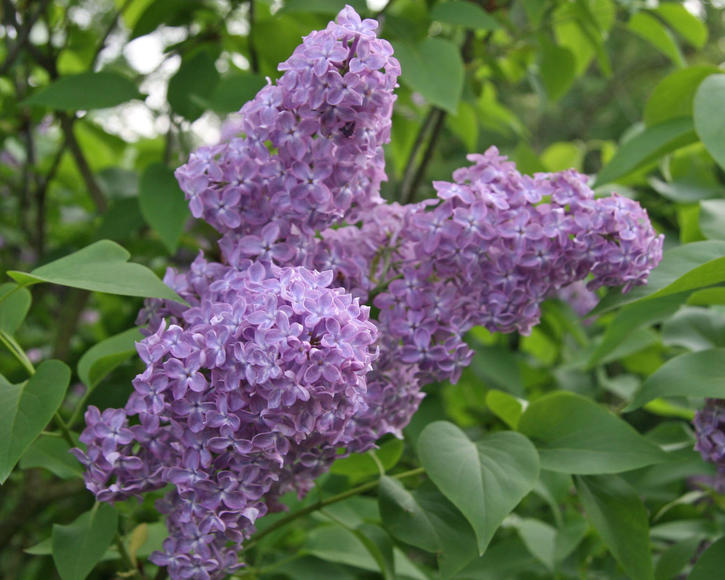Common lilac
The Common lilac entices us with its fragrant flowers that ring in the early summer. How to plant and care for the Common lilac and its hybrids.
Factsheet
- Growth type
-
- large shrub
- Growth height (from)
- from 400 cm to 600 cm
- Growth width (from)
- from 350 cm to 500 cm
- Growth characteristics
-
- sweeping
- upright
- foothills
- tight
- Flower color
-
- purple
- Flowering time (month)
-
- May to June
- Flower shape
-
- panicles
- Flower characteristics
-
- strongly fragrant
- Leaf color
-
- green
- page format
-
- broad ovate
- wide oval
- Fruit color
-
- brown
- Fruit shape
-
- Capsule
- Light
-
- sunny to scattered light
- Soil type
-
- sandy to loamy
- Soil Moisture
-
- moderately dry to moderately humid
- ph value
-
- alkaline to weakly acidic
- Lime compatibility
-
- lime-loving
- Nutrient requirements
-
- nutrient-rich
- Humus
-
- rich in humus
- Decorative or utility value
-
- Flower Decoration
- picturesque growth
- Nectar or pollen plant
- Toxicity
-
- non-toxic
- Winter Hardness
-
- hardy
- Climate zones according to USDA
-
- 4
- Use
-
- Single position
- free growing hedges
- Flower hedges
- Garden style
-
- cottage garden
- Flower garden
- natural garden
- Bee Friendly
- bee friendly plant
The Common lilac (Syringa vulgaris) is a shrub from the olive family (Oleaceae). It originally comes from the Balkan countries, but they have been a part of the classic cottage gardens for centuries. A number of Common lilac hybrids are much more widespread in our gardens than the species.
Syringa vulgaris is a multi-stemmed shrub with rounded branches that can be 13.12 to 19.68 feet high and 11.48 to 16.40 feet wide. It spreads through numerous runners. Another characteristic is its sweeping, broad and picturesque growth.
The Common lilac has coarse, broad, egg-shaped and dark green glossy leaves that are five to twelve centimeters long.
In May, the shrub unfolds its strongly fragrant, blue-violet flowers, which are clustered together in 3.94 to 7.87 inches long, multi-flowered panicles and are often visited by bees and insects. In addition to the species, there are also numerous varieties and hybrids which are single or double-flowered.
The fruits of the Common lilac are brownish, two-lobed capsules.

The fragrant bush prefers a sunny location, but also tolerates partial shade.
Common lilacs thrive best on nutrient-rich, moderately dry to fresh clay soil with a high lime content. A high proportion of sand and humus is also ideal. In general, Syringa vulgaris is very adaptable. It is a particularly hardy and wind-resistant shrub, but does not tolerate compacted or wet soil.
It is best to plant Syringa vulgaris in a planting hole twice the size of the root ball in fall. Put some compost in the pit and water your Lilac well.
Once grown, Syringa vulgaris hardly needs any care. A layer of mature compost around the tree disc supplies the Lilac well with nutrients and holds moisture in the soil. During longer dry periods, you should ensure adequate irrigation — but make sure that there is no waterlogging.
The Common lilac tolerates pruning well. After the flowering period, remove the withered brown panicles by cutting them off above a pair of leaves. Older shrubs that are thinning from the inside can be pruned more aggressively. In contrast to other spring shrubs, the Lilac completes its growth phase after flowering. It is therefore important to clear out old branches in late winter to encourage new growth.
The adaptive common lilac is suitable as a bee pasture and ideal for the scented garden or the cottage garden. If you are looking for an easy-to-care hedge, you need a Lilac hedge. It also cuts a fine figure in a flower hedge in combination with shrubs. The fragrant umbels of the Common lilac can also be cut and placed in the vase.

In addition to the species, there are numerous common lilac varieties with single or double flowers in different shades of blue, purple and pink. “Memento of Ludwig Späth” enchants with dark purple and single double flowers. “Charles Joly” is purple and double flowered variety with an intense fragrance. The Common lilac “Katharine Havemeyer”has semi-double flowers in a beautiful lilac pink. Also beautiful eye-catchers are “Michel Buchner”, a, a pink-purple variety with a white eye and double flowers, and “Madame Antoine Buchner”, , which has double flowers in a delicate mauve pink. “Madame Lemoine” is characterized by double flowers that are creamy yellow in the bud and are a bright white when open. “Primrose” has simple flowers that are greenish-yellow in the bud and are a bright yellow when open. “Sensation”impresses with simple flowers in purple to violet and a silvery border.
The easiest way to do this is to propagate Syringa vulgaris using root runners. In the case of the common varieties, however, in vitro propagation is often used, in which new plants are grown from small pieces of tissue on a nutrient medium. This method of propagation is increasingly replacing grafting.
As with other Lilac species, it can be infested by the Lilac leaf miner moths or leaf miner moths. Brown leaves from May onwards, indicate an infestation. If you see signs of an infestation, immediately search your common lilac for the larvae and remove them from the plant.

